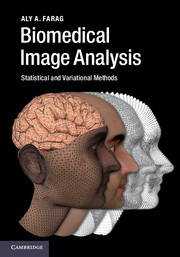Book contents
- Frontmatter
- Dedication
- Contents
- Preface
- Nomenclature
- 1 Overview of biomedical image analysis
- Part I Signals and systems, image formation, and image modality
- Part II Stochastic models
- 4 Random variables
- 5 Random processes
- 6 Basics of random fields
- 7 Probability density estimation by linear models
- Part III Computational geometry
- Part IV Variational approaches and level sets
- Part V Image analysis tools
- Index
- References
6 - Basics of random fields
from Part II - Stochastic models
Published online by Cambridge University Press: 05 November 2014
- Frontmatter
- Dedication
- Contents
- Preface
- Nomenclature
- 1 Overview of biomedical image analysis
- Part I Signals and systems, image formation, and image modality
- Part II Stochastic models
- 4 Random variables
- 5 Random processes
- 6 Basics of random fields
- 7 Probability density estimation by linear models
- Part III Computational geometry
- Part IV Variational approaches and level sets
- Part V Image analysis tools
- Index
- References
Summary
Introduction
This chapter describes the basics of random fields with focus on models that have been useful for image synthesis, filtering, segmentation, and registration. There is a vast literature on the subject. Besag [6.1], Geman and Geman [6.2], Derin and Elliott [6.3], and Dubes and Jain [6.4] are among the accessible literature in this area. Various books and monograms exist as well. Rue and Held [6.5], and Adler and Taylor [6.6] deal with some basics of random fields, and Blake et al. [6.7] contains examples of applied work on the random field in image analysis and computer vision. From an algorithmic point of view, Dubes and Jain [6.4] is excellent introductory reading.
In simple terms, a random field is a random process in which the index set is multidimensional. As random variables are the building blocks of random processes, they are also the basic ingredients of random fields. To introduce the subject of random fields, we provide examples of random experiments that produce outputs in one or more dimensions.
Information
- Type
- Chapter
- Information
- Biomedical Image AnalysisStatistical and Variational Methods, pp. 131 - 162Publisher: Cambridge University PressPrint publication year: 2014
